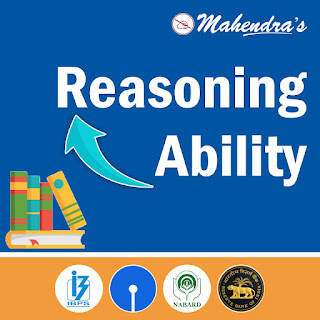Dear Readers,
Mahendras has started special quizzes for IBPS | RBI | SBI | NABARD Exam so that you can practice more and more to crack the examination. IBPS | RBI | SBI | NABARDspecial quiz series will mold your preparations in the right direction and the regular practice of these quizzes will be really very helpful in scoring good marks in the Examination. Here we are providing you the important question of reasoning ability for the IBPS | RBI | SBI | NABARD Exam.
Directions (Q. 1-3): Read the following information carefully and answer the questions given below.
P+Q means P is mother of Q
P- Q means P is father of Q
P/ Q means P is sister of Q
P*Q means P is wife of Q
P%Q means P is son of Q
Q.1. If ‘M+S+N%P’, then how is M related to N?
(1) Grandson
(2) Maternal grandmother
(3) Paternal grandmother
(4) Granddaughter
(5) None of these
Q.2. If ‘P%T- Q/ U%R, then how is U related to T?
(1) Father
(2) Mother
(3) Son
(4) Daughter
(5) None of these
Q.3. Which of the following shows that J is sonin-law of I?
(1) N*I-L- K/M%J
(2) N*I-L+K/M%J
(3) I-L+K/M+N%J
(4) N*I-L- K/M+J
(5) None of these
Directions (Q. 4-6):
Read the following information carefully and answer the questions given below. R is the father of P, who is a son-in-law of M and S is the mother of G. S is a sister of K, who is a brother-in-law of P and H is the daughter of T, who is a grandmother of G.
Q.4. How is G related to P?
प्रश्न 4. G, P से किस प्रकार संबंधित है?
यदि M एक महिला है, तो H, S से किस प्रकार संबंधित है?
यदि K, N से विवाहित है, तो N, M से किस प्रकार संबंधित है?
(1) Son
(2) Daughter
(3) Granddaughter
(4) Grandson
(5) Cannot be determined
Q.5. If M is a female, then how is H related to S?
(1) Sister
(2) Sister-in-law
(3) Niece
(4) Cannot be determined
(5) None of these
Q.6. If K married to N, then how is N related to M?
(1) Son-in-law
(2) Daughter-in-law
(3) Mother-in-law
(4) Father-in-law
(5) None of these
Q.7. Pointing a photograph, Sheela said, he is the only son of my grandfather’s only son. How is the boy in the photograph related to Sheela?
(1) Brother
(2) Cousin
(3) Son
(4) Cannot be determined
(5) None of these
Q.8. Pointing a girl, Prasan said, she is the only granddaughter of my wife’s grandfather’s only child. How is the girl related to Prasan?
(1) Sister
(2) Niece
(3) Daughter
(4) Cannot be determined
(5) None of these
Q.9. P is the sister of Q. R is the father of S, who is the brother of Q. R married to T. How is Q related to T?
(1) Son
(2) Daughter
(3) Either son or daughter
(4) Date inadequate
(5) None of these
Q.10. G is the father of K, who is the brother of B. K married to U. B is the daughter of C. D is the father of U and M is the only son of D.How is U related to C?
(1) Daughter
(2) Daughter-in-law
(3) Granddaughter
(4) Son-in-law
(5) None of these
Answers:-
Q.1 (2)
Q.2 (3)
Q.3 (2)
Q.4 (5)
Q.5 (2)
Q.6 (2)
Q.7 (4)
Q.8 (3)
Q.9 (3)
Q.10 (2)





.jpg)
0 comments:
Post a Comment
MAHENDRA GURU